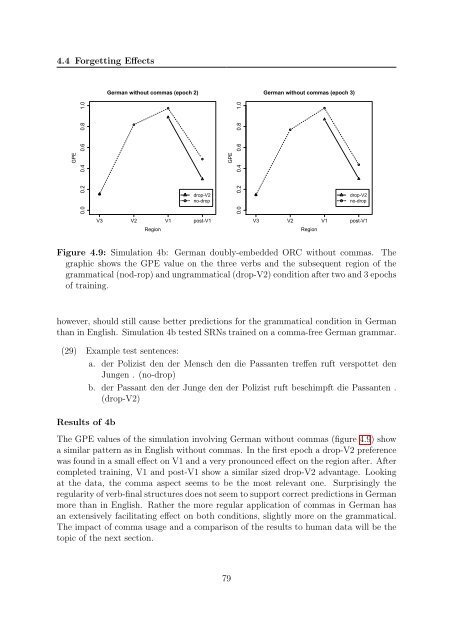Connectionist Modeling of Experience-based Effects in Sentence ...
Connectionist Modeling of Experience-based Effects in Sentence ...
Connectionist Modeling of Experience-based Effects in Sentence ...
You also want an ePaper? Increase the reach of your titles
YUMPU automatically turns print PDFs into web optimized ePapers that Google loves.
4.4 Forgett<strong>in</strong>g <strong>Effects</strong><br />
GPE<br />
0.0 0.2 0.4 0.6 0.8 1.0<br />
German without commas (epoch 2)<br />
V3 V2 V1 post-V1<br />
Region<br />
drop-V2<br />
no-drop<br />
GPE<br />
0.0 0.2 0.4 0.6 0.8 1.0<br />
German without commas (epoch 3)<br />
V3 V2 V1 post-V1<br />
Region<br />
drop-V2<br />
no-drop<br />
Figure 4.9: Simulation 4b: German doubly-embedded ORC without commas. The<br />
graphic shows the GPE value on the three verbs and the subsequent region <strong>of</strong> the<br />
grammatical (nod-rop) and ungrammatical (drop-V2) condition after two and 3 epochs<br />
<strong>of</strong> tra<strong>in</strong><strong>in</strong>g.<br />
however, should still cause better predictions for the grammatical condition <strong>in</strong> German<br />
than <strong>in</strong> English. Simulation 4b tested SRNs tra<strong>in</strong>ed on a comma-free German grammar.<br />
(29) Example test sentences:<br />
a. der Polizist den der Mensch den die Passanten treffen ruft verspottet den<br />
Jungen . (no-drop)<br />
b. der Passant den der Junge den der Polizist ruft beschimpft die Passanten .<br />
(drop-V2)<br />
Results <strong>of</strong> 4b<br />
The GPE values <strong>of</strong> the simulation <strong>in</strong>volv<strong>in</strong>g German without commas (figure 4.9) show<br />
a similar pattern as <strong>in</strong> English without commas. In the first epoch a drop-V2 preference<br />
was found <strong>in</strong> a small effect on V1 and a very pronounced effect on the region after. After<br />
completed tra<strong>in</strong><strong>in</strong>g, V1 and post-V1 show a similar sized drop-V2 advantage. Look<strong>in</strong>g<br />
at the data, the comma aspect seems to be the most relevant one. Surpris<strong>in</strong>gly the<br />
regularity <strong>of</strong> verb-f<strong>in</strong>al structures does not seem to support correct predictions <strong>in</strong> German<br />
more than <strong>in</strong> English. Rather the more regular application <strong>of</strong> commas <strong>in</strong> German has<br />
an extensively facilitat<strong>in</strong>g effect on both conditions, slightly more on the grammatical.<br />
The impact <strong>of</strong> comma usage and a comparison <strong>of</strong> the results to human data will be the<br />
topic <strong>of</strong> the next section.<br />
79
















